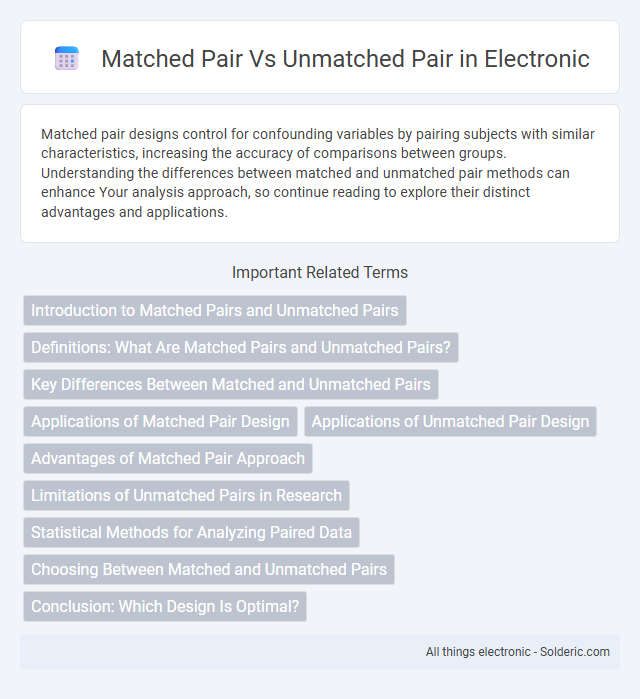Matched pair designs control for confounding variables by pairing subjects with similar characteristics, increasing the accuracy of comparisons between groups. Understanding the differences between matched and unmatched pair methods can enhance Your analysis approach, so continue reading to explore their distinct advantages and applications.
Comparison Table
| Feature | Matched Pair | Unmatched Pair |
|---|---|---|
| Definition | Pairs of subjects matched based on similar characteristics. | Subjects grouped independently without matching. |
| Purpose | Controls confounding variables for accurate comparison. | Simple comparison without pairing or controlling variables. |
| Data Dependency | Dependent data; observations linked by pair. | Independent data; observations unlinked. |
| Statistical Tests | Paired t-test, Wilcoxon signed-rank test. | Independent t-test, Mann-Whitney U test. |
| Sample Size | Requires equal sample sizes in pairs. | No requirement for equal group sizes. |
| Example Use Case | Pre-test and post-test measurements on same subjects. | Comparing test scores between two unrelated groups. |
Introduction to Matched Pairs and Unmatched Pairs
Matched pairs involve pairing subjects based on similar characteristics to reduce variability and improve the accuracy of statistical comparisons, while unmatched pairs analyze independent groups without such pairing. Matched pair designs are commonly used in controlled experiments and clinical trials to minimize confounding variables. Your choice between matched and unmatched pairs impacts the statistical methods and interpretation of results in research analysis.
Definitions: What Are Matched Pairs and Unmatched Pairs?
Matched pairs refer to study designs where participants are paired based on similar characteristics to reduce variability, often used in controlled experiments and observational studies. Unmatched pairs involve independent samples where there is no intentional pairing or matching between individuals, allowing for comparisons across distinct groups. Your choice between matched and unmatched pairs depends on the study's goal to control for confounding variables or to analyze broader population differences.
Key Differences Between Matched and Unmatched Pairs
Matched pairs involve paired observations where each subject in one group is directly linked to a specific subject in the other group, often through variables such as age, gender, or pre-test scores, enhancing control over confounding factors. Unmatched pairs refer to independent samples with no inherent linkage between subjects, increasing variability but simplifying experimental design and analysis. The primary difference lies in dependent versus independent sampling, impacting statistical tests like paired t-test for matched pairs and independent t-test for unmatched pairs.
Applications of Matched Pair Design
Matched pair design is widely applied in clinical trials to reduce variability by pairing subjects with similar characteristics, enhancing the accuracy of treatment effect estimation. It is commonly used in psychology and education research where participants' pre-test scores serve as matching criteria, improving the sensitivity of outcome measures. In agricultural studies, matched pairs help control environmental factors by pairing plots with comparable soil conditions, thereby isolating treatment effects more effectively.
Applications of Unmatched Pair Design
Unmatched pair design is widely applied in observational studies and clinical trials where random assignment is impractical, allowing comparison between independent groups without the need for pairing subjects. This design is particularly useful in epidemiological research for assessing risk factors across different populations and in medical research for comparing treatment effects among unrelated patients. Unmatched pair designs facilitate the analysis of large and diverse datasets where matching criteria cannot be strictly enforced.
Advantages of Matched Pair Approach
The matched pair approach enhances statistical power by controlling for confounding variables through the pairing of subjects with similar characteristics. This method reduces variability within treatment comparisons, leading to more precise estimates of treatment effects. It is particularly advantageous in clinical trials and observational studies where controlling for individual differences is critical to data integrity.
Limitations of Unmatched Pairs in Research
Unmatched pairs in research often lead to increased variability and potential confounding due to lack of control over individual differences, reducing statistical power. This limitation hinders the ability to isolate the treatment effect because unmatched groups may differ significantly in baseline characteristics. Consequently, unmatched pair designs require larger sample sizes to achieve comparable precision to matched pair studies.
Statistical Methods for Analyzing Paired Data
Statistical methods for analyzing paired data primarily involve matched pairs tests like the paired t-test and the Wilcoxon signed-rank test, which account for the inherent correlation between paired observations, improving the accuracy of the inference. In contrast, unmatched pair data are analyzed using independent sample tests such as the two-sample t-test or the Mann-Whitney U test, assuming independence between groups. Proper selection between matched and unmatched pair analysis is critical for valid hypothesis testing and controlling Type I and Type II error rates.
Choosing Between Matched and Unmatched Pairs
Choosing between matched and unmatched pairs depends on the study design and research goals, where matched pairs control for confounding variables by pairing subjects based on similar characteristics, enhancing statistical power in paired t-tests or matched case-control studies. Unmatched pairs are preferable when random assignment is possible and independent samples are adequate, simplifying data collection and analysis without the need for pairing criteria. Consider factors like sample size, variability, and the potential for bias to determine whether pairing subjects improves accuracy or if independent sampling suffices for valid inference.
Conclusion: Which Design Is Optimal?
Matched pair designs optimize statistical power by controlling confounding variables through pairing similar subjects, making them ideal for small sample sizes and reducing variability. Unmatched pair designs offer simplicity and flexibility for larger, more diverse populations but typically require larger sample sizes to achieve comparable power. Selecting an optimal design depends on study objectives, sample size, and available resources; matched pair designs generally yield more precise estimates when controlling for covariates is critical.
Matched pair vs Unmatched pair Infographic

 solderic.com
solderic.com